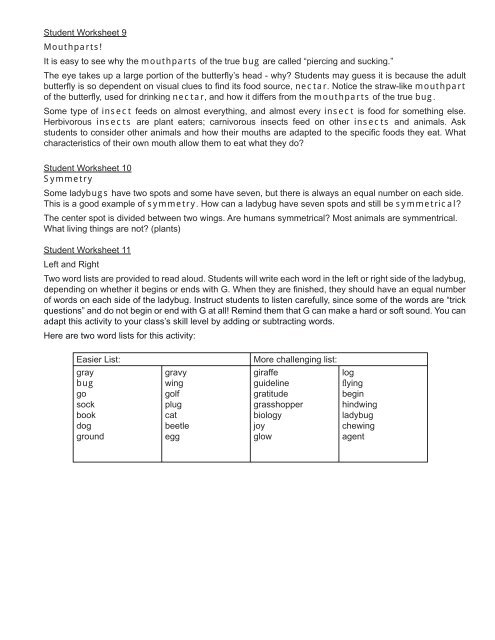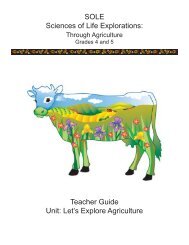Insect Anatomy - Agriculture in the Classroom
Insect Anatomy - Agriculture in the Classroom
Insect Anatomy - Agriculture in the Classroom
Create successful ePaper yourself
Turn your PDF publications into a flip-book with our unique Google optimized e-Paper software.
Student Worksheet 9<br />
Mouthparts!<br />
It is easy to see why <strong>the</strong> mouthparts of <strong>the</strong> true bug are called “pierc<strong>in</strong>g and suck<strong>in</strong>g.”<br />
The eye takes up a large portion of <strong>the</strong> butterfly’s head - why Students may guess it is because <strong>the</strong> adult<br />
butterfly is so dependent on visual clues to f<strong>in</strong>d its food source, nectar. Notice <strong>the</strong> straw-like mouthpart<br />
of <strong>the</strong> butterfly, used for dr<strong>in</strong>k<strong>in</strong>g nectar, and how it differs from <strong>the</strong> mouthparts of <strong>the</strong> true bug.<br />
Some type of <strong>in</strong>sect feeds on almost everyth<strong>in</strong>g, and almost every <strong>in</strong>sect is food for someth<strong>in</strong>g else.<br />
Herbivorous <strong>in</strong>sects are plant eaters; carnivorous <strong>in</strong>sects feed on o<strong>the</strong>r <strong>in</strong>sects and animals. Ask<br />
students to consider o<strong>the</strong>r animals and how <strong>the</strong>ir mouths are adapted to <strong>the</strong> specific foods <strong>the</strong>y eat. What<br />
characteristics of <strong>the</strong>ir own mouth allow <strong>the</strong>m to eat what <strong>the</strong>y do<br />
Student Worksheet 10<br />
Symmetry<br />
Some ladybugs have two spots and some have seven, but <strong>the</strong>re is always an equal number on each side.<br />
This is a good example of symmetry. How can a ladybug have seven spots and still be symmetrical<br />
The center spot is divided between two w<strong>in</strong>gs. Are humans symmetrical Most animals are symmentrical.<br />
What liv<strong>in</strong>g th<strong>in</strong>gs are not (plants)<br />
Student Worksheet 11<br />
Left and Right<br />
Two word lists are provided to read aloud. Students will write each word <strong>in</strong> <strong>the</strong> left or right side of <strong>the</strong> ladybug,<br />
depend<strong>in</strong>g on whe<strong>the</strong>r it beg<strong>in</strong>s or ends with G. When <strong>the</strong>y are f<strong>in</strong>ished, <strong>the</strong>y should have an equal number<br />
of words on each side of <strong>the</strong> ladybug. Instruct students to listen carefully, s<strong>in</strong>ce some of <strong>the</strong> words are “trick<br />
questions” and do not beg<strong>in</strong> or end with G at all! Rem<strong>in</strong>d <strong>the</strong>m that G can make a hard or soft sound. You can<br />
adapt this activity to your class’s skill level by add<strong>in</strong>g or subtract<strong>in</strong>g words.<br />
Here are two word lists for this activity:<br />
Easier List:<br />
gray<br />
bug<br />
go<br />
sock<br />
book<br />
dog<br />
ground<br />
More challeng<strong>in</strong>g list:<br />
gravy<br />
w<strong>in</strong>g<br />
golf<br />
plug<br />
cat<br />
beetle<br />
egg<br />
giraffe<br />
guidel<strong>in</strong>e<br />
gratitude<br />
grasshopper<br />
biology<br />
joy<br />
glow<br />
log<br />
fl y<strong>in</strong>g<br />
beg<strong>in</strong><br />
h<strong>in</strong>dw<strong>in</strong>g<br />
ladybug<br />
chew<strong>in</strong>g<br />
agent
















